
duke : surfboard riding, part 2, 1911
| home | catalogue | history | references | appendix |
 |
surfresearch.com.au
duke : surfboard riding, part 2, 1911 |
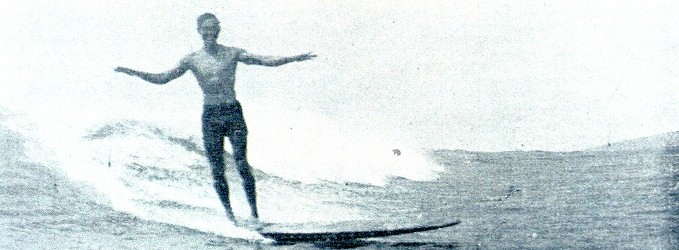
Riding the
Surfboard
(continued)
It is difficult to learn to ride
the surfboard without an instructor, but a few simple hints
will enable anyone to master the art.
I quote from one who learned and
wrote of his experiences :
The small boys of Waikiki took me
in hand when I was ready to take my first lesson on the
surfboard.
It is their delight to initiate
the malihini (stranger).
Few of them get beyond the
initiatory exercises.
I was given a board, a hit of
redwood, pointed at one end, not six feet long, about sixteen
inches wide and perhaps an inch and a half thick.
"Just follow us," called one of
the three eager tutors selected from the delighted group of
would-be instructors.
Soon we were out in deep water.
Nearly a mile out at sea the big,
long billows, for which we were headed began their thrilling
run, to break and reform thrice before reaching the beach.
The first bit of advice from my
tiny tutors was: "'If a breaker does strike us, just duck the
bow of your board and it will go through." .
Each of the
youngsters was now laying fiat on his board, the tips of his
feet just lapping over the end, and the small arms revolving
like windmills as the three boards flew through the water,
while mine lumbered on far behind.
"Come on" they called in chorus, and I tried to obey.
The windmill motion consists of keeping the arms going around like the sails of a windmill on either side of the board, and strange to say, once the muscles of the arms and shoulders are accustomed to this motion, it tires less than any regular form of swimming.
The first
of my troubles was that my chest where it rested on the
board began to chafe and ache; this the small boys pleaded
with me not to mind, as in a day or so I would not notice it
at all; this I later found to be true, but that first
afternoon it did not seem possible that my ribs would not in
time tear through the skin.
However, I
struggled on, and we approached the great rollers.
The first wave we permitted to pass under us; then there was a cry of "na-
Page 152
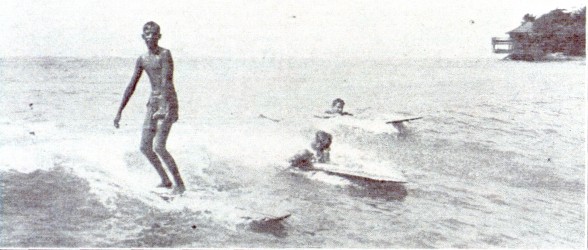
In the
Small Surf Near the Beach.
Photo
by
Ferris
lunui" (big
wave coming); then "Hoe ! - Hoe !"
I felt
myself lifted on the advancing slope of the oncoming billow,
three pairs of active young muscles gave my board a great
start forward.
The
advancing waters caught it and I lunged onward and downward
as though shot from a cannon.
I was well
forward on my board- in accord with instructions carefully
instilled, my feet flew up into the air- I clung to the bow
of my plank and with it did a series of cart-wheels to the
accompaniment of a chorus of cheers and shouts of laughter;
the small boys had also plunged forward, using their bodies
as animated surfboards, and were riding my wave au-naturel.
As it
finally passed me by and I came up in its rear I could see
their smiling, happy faces on its crest turned toward me.
There was a
chorus of "You were too far forward on your board,"an
exchange of gleeful chuckles, and the three youngsters
descended on my side of the wave to give me the second
degree.
"Always let your board go when she starts to dive," one of them urged, "because sometimes if the surf is very high she goes down 'til she strikes coral at the bottom."
Another of
these cheerful, charming youngsters now thought it time to
ask if I could swim.
It seems
there are persons foolish enough to come out half a mile
from shore on a surfboard who cannot swim a stroke.
I assured
my initiators that I could swim, and, their conscience at
absolute peace, they prepared to proceed with the grilling.
I was told
to hold the board amidship and half kneel; it was explained
that in this posture the wave would strike and carry me on
at great speed.
It did, but
the board was left behind.
Other
youngsters of all shades and complexions, and gleaming
hides, that shone dripping and resplendent in the sun, had
now gathered to witness the sport, and everyone was invited
to participate in the giving of the great third degree.
I have a
vivid recollection of strange shouts, my board almost jerked
from under me, shot forward, and I, surrounded by the white,
foaming water, began sinking downward as on a toboggan
slide, yet onward with the speed of a cannon ball- the spray
almost blinding and strangling me; then as I sank, clinging
to my board, halfway down the slide of the wave, I could
begin to take notice. On either side of me were my angelic
tormentors standing erect on their boards, shouting
encouragement and urging me on- though I could stop in that
mad rush of waters even
Page 153
if I wished
to.
From the
crest of the wave a brown skinned native Hawaiian dived from
his board and arose beside me to shout confusing orders in
my face- from the other side another youngster dived from
his board and arose to grasp mine.
It tilted,
and there was a shout of glee; it took the great green wall
of water on the bias, skimmed along at accelerated speed-
diagonally- and I could see the havoc that was coming;
boards dove under me- boys over me, and one landed on the
small of my back; there was a general confusion and mix-up
in the seething waters, and I emerged from the third degree
coughing and spluttering to be taken in hand for my diploma
and final 33rd degree.
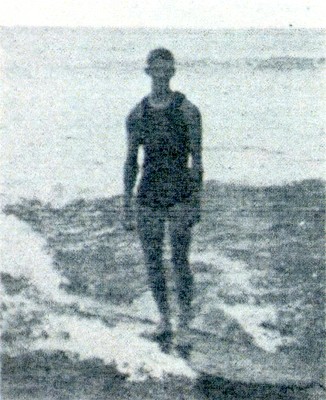 |
On the Center of the Board. Left:
|
 |
The wave
came, the start was made, and my bit of wood was fairly
caught in the rush of waters.
Steady and
even she rode the wave, then the cry came to "stand !"
I tried it.
There was a
rapid divorce from my board; we met later, and I was pulled
away from the wreck.
Unanimously
it was agreed that I had earned my diploma, and was worthy
to learn the art of riding a surfboard.
"But I can
ride," I expostulated.
There was a
roar of hilarious, derisive laughter, and one of the
youngsters cried:
"Come on,
then- let her go."
Instantly
all hands began to paddle - the windmills were in full swing
and the boards shot through the waters (all but mine),
caught the advancing slope, slid downward, and were carried
in in the rush.
I sank back
behind the wave with my board as though I had never made an
effort to go forward.
Again and
again the attempt was made, and again and again failure was
the result.
It was easy
enough to understand just how the thing was done by watching
others go through the operation- but that was no practical
help.
The boys
were right when they advised, "It takes experience; just
keep at it; some day you'll learn the trick, and then
Page 154
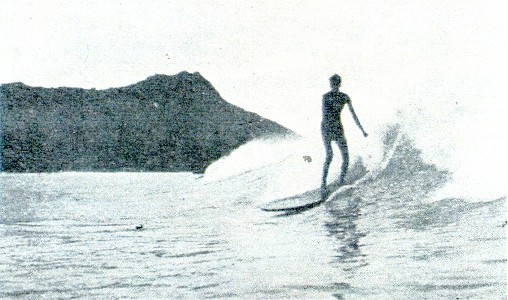
Coming
Down the Base of the Wave.
you'll wonder how it was you didn't get it the first day."
There were
many things to learn before I could hope of my own
initiative to catch the wave.
First I must
acquire a speed that would send me through the water as fast
as its movement at the base of a billow.
I must
develop muscle that would stand for continued stustained
effort; only practice would perfect the windmiIl stroke, and
that I must acquire.
True, I
might learn to ride in on the minor waves that break near
the beach- mere ruffles- by pushing my board forward and
throwing myself upon it, but comparatively, that was tame
sport, and even that I found difficult of accomplishment.
My young
friends grew earnest ill their efforts to teach me the trick
as the days grew into weeks and they saw that I stuck at my
task.
Sometimes it
was three hours a day; some-
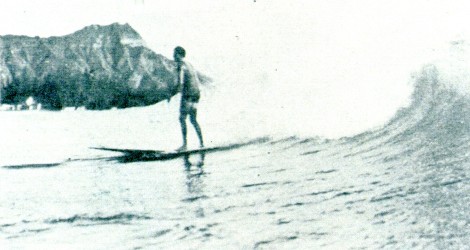
Before the
Comber
Page 155
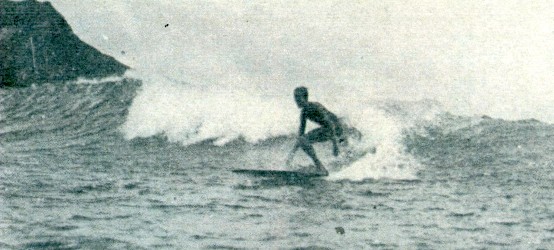
times six,
and a week of torturing sunburn through it all.
In the
shallows I could stand knee deep, the end of my board braced
against the pit of my stomach, sometimes a score of small
wavelets would be allowed to pass, and then the real wave
would approach, anxious eyes would watch, and at the
pyschological moment the cry of "go" would issue
simultaneously from several mouths, and I would urge my
board forward.
Often all
was failure, because I failed to kick and paddle at exactly
the right moment and in exactly the proper way; sometimes by
an accident I never analyzed, I blundered into the right
combination and shot forward on the down slide of the
wavelet.
I could not
understand how with all my exertion and energy, I invariably
fell in the rear and sank, while my comrades seemingly with
littIe effort and the gentlest of gliding motions shot ahead
and kept the crest of the waves just behind them, while some
few, even upon the tiniest of wavelets, stood upon their
boards and urged them onward with a shoving movement of the
foot.
It seemed to
me that my teachers must give me up as an inapt pupil, and
they did, wiith the bit of encouragement that, "only
experience" would teach me.
I learned
in half an hour the secret I had sought for weeks.
A young
hapahaole (half-white, half-native) took pity on me.
He was the
champion surfer of the Islands- who, on a brief visit to
America once astonished the natives of Atlantic City and was
arrested by the police for riding in on an ironing board
upon the top of a great roller, to the seeming peril of the
hundreds of conventional bathers

Coming in
to the Beach
Page 156
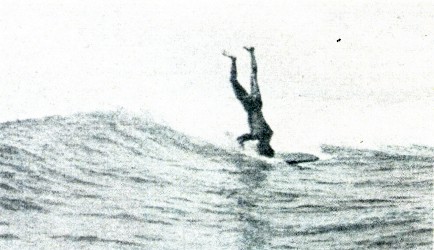
Easier
Than It Looks.
in the surf- the first time in America, doubtless, that the little board was used in our breakers- and half an hour after this hero took me in hand I was riding the surf to my heart's content.
The first
bit of instruction from my new tutor was to balance myself;
he showed me how in shallow water he could stand until the
wave was almost upon him, and then spring sideways upon the
board, balancing so that resting on the tips of two ribs he
could wheel about as on a pivot- then he showed me how, in
deep water, to mount my plank with a sideways motion.
My premier
lesson was in the shallows.
"First,"
said my instructor, "I want you to learn how to go before a
wave; get on your board, now put your arms out straight,
perfectly rigid - go."
The wave
came, there was a gentle shove from behind, I kicked my feet
up and down as instructed, and shot forward- it was a
complete success.
The next
time I bent my elbows and slipped back through the wave.
"That acts
as a brake," said my instructor; ''as long as you keep your
arms rigid you can go before the smallest wave, but the
moment you bend them, back you slide.
If you want
to get up on your board, jerk yourself up quickly without
bending your elbows.
The bigger
the wave the farther back on the board you should be, then
as you get in front of thewave and it begins to wear itself
out, work yourself up to the forward end of the board
without bending the elbows.
Never let
anyone fool you into getting behind your board and starting
by putting the end of it against the stomach and springing
forward with the wave; someday a big wave wiII come along,
lift you up, the bow of your board will strike bottom, stand
on end, and there you'll dangle- if the board strikes coral
it may split and you'll be lucky if you escape
disembowelment- I've seen it happen- the deep water for
mine."
And so with
sensible hints here and there my instructor quickly
initiated me into the mysteries of the board; its secrets
became mine.
When I would
get a fair start and bring up broadside to the wave, my
tutor was there to stop me.
Soon I
learned, by balancing myself amidships and waving my legs,
from the hips down, either one side or the other, to
perfectly guide my board before any kind of breaker.
In a little
while this method seemed to be acquired most naturally.
I was ready
now to practice by myself, first in the shallows, springing
on my board with a forward shove just before the wave broke,
and catching its momentum-and in deep
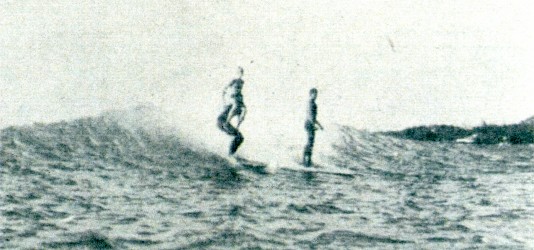
Experts at
Ease in the Surf
Page 157
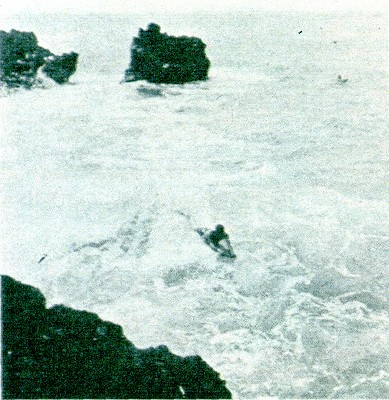
Surfing
Off a Rock-bound Coast of Hawall.
water by
remaining on my board and watching for the proper wave.
But there
again I had to be taught how to judge the waves and which to
trust myself upon- in fact, with the instruction of a man
who knows how to teach, anyone may acquire the art of
surf-boarding to perfection.
I learned
not to take the dull, heavy-moving waves or the double ones,
but to wait patiently for the oncoming roller with jagged,
razor-like edge.
Then at the
right moment my arms would go swinging around, my board
would gather momentum, I would feel my feet lifted high in
air and, then the everlasting race down hill- or perhaps I
would be lifted to the crest of the wave, my head and
shoulders clear- where I could gaze down at the hollow
six or eight feet below.
Sometimes
the rushing crest would break and I would be hurled from my
board, which would fly ten feet in the air, while I would
drop into the abyss, my arms outstretched. and perhaps for a
hundred yards be carried forward with the speed of a cannon
ball before the wave, surfing without a board.
At other
times. as it more frequently happened. my board would shoot
downward, no matter how far back I slipped, until I would
take a dive far- far- down- and, released from all weight,
the board would shoot high in the air, while I remained
under water for as long as I could so as not to I meet the
descending piece of wood.
I was soon
ready for my lesson in standing on the board.
Each local
expert explained how it was done, and I made the attempt.
At first I
turned the board over the moment I drew my arms down to
clasp its edges firmly, preparatory to lifting myself up.
Wild cries
of delight notified me that I had missed again.
It was my
ever generus tutor who once more came to the rescue.
"Take a big board at first," he said; 'a wide one, then rise just as you break through the wave and your board lies flat in front of it. Rise quickly by sliding your hands back to the middle of the board, rise from the waist line, one foot in front of the other as though kneeling; then spring up."
I did, and
over I went to the intense delight of my juvenile audience
that caught each wave and even circled about me.
Again and
again I tried, and at last a breaker heavier thall all the
others upset several of my little tormentors, while I
clasped my board
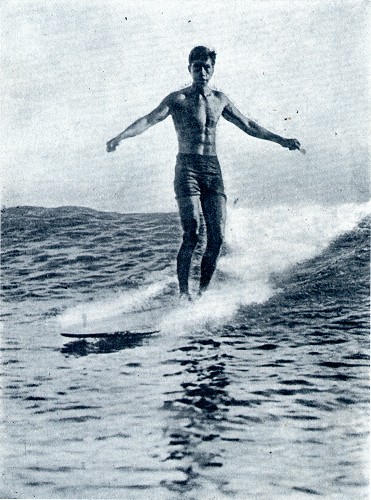 |
Also in:
|
Page 158
firmly
plunged down from the top of the breaker to the hollow,
missed the usual dive, and skimmed along at breakneck speed.
It was now
or never - I leaped to my feet in the rush of waters, my
board stood firm and steady, I did not dare move, and my
arms swung like windmills as I endeavored to keep my
balance- each moment I expected to fall- my wave died out as
another onrush took its place, and still I stood.
I could not
believe it - I knew it was all a happy accident; the beach
rushed to meet me, and suddenIy I stood upon my board on the
sands, lurched forward and sprawled full length, high and
dry on the beach of Waikiki.
Far, far out
in the big breakers were my former tormentors; they raised
themselves on their boards and cheered.
I was no
longer a malihini.
I was a
kamaaina (an old-timer), and as such I was accepted
thereafter by the boys of Waikiki.
When it had
been fairly demonstrated that the white man could learn all
the secrets of the surfboard acquired by the Hawaiian-born,
the beach at Waikiki took on a new aspect.
The people
of Honolulu turned their attention to the reviving of the
old-time Hawaiian water sports.
Hundreds
learned to ride the surfboard, and feats were accomplished
by the haole never dreamed of by the kanaka.
During the
visits of the fleets, surfing carnivals were held, small
boys and men, to the astonishment of the jackies, came in
upon their boards, on their heads.
At night
time the expert surfers carried red light contrivances on
the bows of their boards, and in the caps on their heads,
matches, with which they set off the glaring colored lights
just before they caught some monster wave, and then those on
the beach were treated to the sight of radiant gods of the
sea ontlined against the darkness standing upon the white
crests of the waves, which they rode, as we have seen the
acrobat in a circus ride his milk-white steed, erect and
elated, only these gods of the sea approached more rapidly
than could the swiftest horses, and as they stepped, after
their mile run, from the tip of the wave to the hard sea
sand of the beach, others took their place to demonstrate
that the most thrilling sport in the world- surfboarding- is
the possible accomplishment of anyone who makes up his mind
that he will master it.

|
Published by Alexander Hume Ford, Honolulu, Territory of Hawaii, Volume 1, Number 2, February,1911 |

| home | catalogue | history | references | appendix |